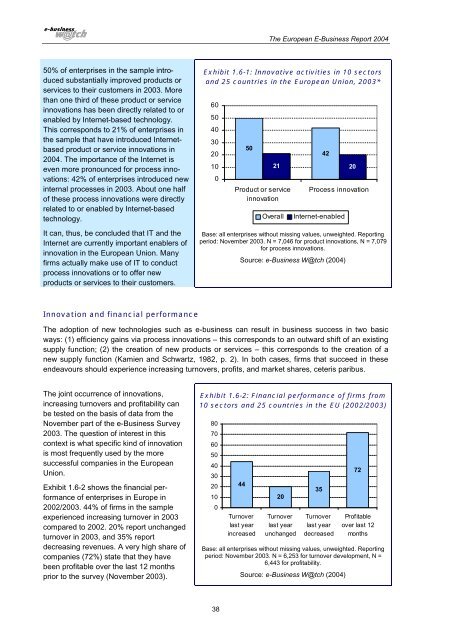The European e-Business Report 2004 - Berlecon Research GmbH
The European e-Business Report 2004 - Berlecon Research GmbH
The European e-Business Report 2004 - Berlecon Research GmbH
Create successful ePaper yourself
Turn your PDF publications into a flip-book with our unique Google optimized e-Paper software.
<strong>The</strong> <strong>European</strong> E-<strong>Business</strong> <strong>Report</strong> <strong>2004</strong>50% of enterprises in the sample introducedsubstantially improved products orservices to their customers in 2003. Morethan one third of these product or serviceinnovations has been directly related to orenabled by Internet-based technology.This corresponds to 21% of enterprises inthe sample that have introduced Internetbasedproduct or service innovations in<strong>2004</strong>. <strong>The</strong> importance of the Internet iseven more pronounced for process innovations:42% of enterprises introduced newinternal processes in 2003. About one halfof these process innovations were directlyrelated to or enabled by Internet-basedtechnology.It can, thus, be concluded that IT and theInternet are currently important enablers ofinnovation in the <strong>European</strong> Union. Manyfirms actually make use of IT to conductprocess innovations or to offer newproducts or services to their customers.Exhibit 1.6-1: Innovative activities in 10 sectorsand 25 countries in the <strong>European</strong> Union, 2003*605040302010050Product or serviceinnovationOverall4221 20Process innovationInternet-enabledBase: all enterprises without missing values, unweighted. <strong>Report</strong>ingperiod: November 2003. N = 7,046 for product innovations, N = 7,079for process innovations.Source: e-<strong>Business</strong> W@tch (<strong>2004</strong>)Innovation and financial performance<strong>The</strong> adoption of new technologies such as e-business can result in business success in two basicways: (1) efficiency gains via process innovations – this corresponds to an outward shift of an existingsupply function; (2) the creation of new products or services – this corresponds to the creation of anew supply function (Kamien and Schwartz, 1982, p. 2). In both cases, firms that succeed in theseendeavours should experience increasing turnovers, profits, and market shares, ceteris paribus.<strong>The</strong> joint occurrence of innovations,increasing turnovers and profitability canbe tested on the basis of data from theNovember part of the e-<strong>Business</strong> Survey2003. <strong>The</strong> question of interest in thiscontext is what specific kind of innovationis most frequently used by the moresuccessful companies in the <strong>European</strong>Union.Exhibit 1.6-2 shows the financial performanceof enterprises in Europe in2002/2003. 44% of firms in the sampleexperienced increasing turnover in 2003compared to 2002. 20% report unchangedturnover in 2003, and 35% reportdecreasing revenues. A very high share ofcompanies (72%) state that they havebeen profitable over the last 12 monthsprior to the survey (November 2003).Exhibit 1.6-2: Financial performance of firms from10 sectors and 25 countries in the EU (2002/2003)8070605040302010044Turnoverlast yearincreased20Turnoverlast yearunchanged35Turnoverlast yeardecreased72Profitableover last 12monthsBase: all enterprises without missing values, unweighted. <strong>Report</strong>ingperiod: November 2003. N = 6,253 for turnover development, N =6,443 for profitability.Source: e-<strong>Business</strong> W@tch (<strong>2004</strong>)38
















